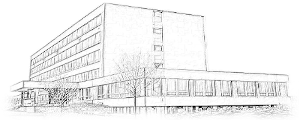Fluid jets department
The department mainly focuses on the study and analysis of disintegration processes of materials and geomaterials by high-speed water jets, examines the possibilities of increasing the water jet efficiency, and investigates new applications of water jets.
Application laboratory
- Water jet workplace (PDF, 95 kB)
Research directions
- Study of the dynamic behaviour of pulsating water flow, the definition of the natural relationship of the processes of excitation and propagation of high-frequency pressure pulsations in liquid, and their utilization for a generation of pulsating high-speed liquid jets
- Theoretical study of complex dynamic processes occurring during the excitation and propagation of high-frequency pressure pulsations in liquid with the aid of numerical simulations and CFD (Computational Fluid Dynamics) methods
- Experimental research of dynamic processes occurring during the excitation and propagation of high-frequency pressure pulsations in liquid using the direct measurement of the frequency and amplitude of dynamic pressure in a high-pressure system as well as stagnation force generated by the impact of the pulsating jet
- Study of forming the pulse in a high-speed water jet downstream from the nozzle exit with the aid of PIV (particle image velocimetry) and shadowgraph methods
- Study of the interaction of the pulsating jet with the material using optical methods and image analysis
- Testing of the cutting and disintegration effects of the pulsating water jets on various materials to compare their performance with continuous jets and, eventually, with other technologies
- Understanding the fundamental processes of the generation and transmission of pressure pulsations in a high-pressure system, the formation of a pulsating jet and its interaction with material
- Improvement of acoustically-generated pulsating water jets, development of hydrodynamic nozzle, development of new abrasive head in order to improve its lifetime and reduce energy consumption
- Research in the area of new abrasive materials (both natural and artificially produced)
- Study of the properties and behaviour of abrasive particles in the processes of generating of abrasive water jets and material cutting
- Preparation, testing and recycling of abrasives
- Definition of the crucial properties of abrasive materials from the point of view of both maximizing the cutting performance and minimizing the wear of the cutting head, the economic cost, and the negative impacts on the working and living environment
- Study of liquid behaviour within the nozzle and downstream from the nozzle exit by numerical simulation and validation experiments
- Optimization of liquid flow in high pressure systems to obtain the best efficiency; strength analysis of given components
- Analysis and optimisation of compressible gas or liquid flow, mixture and multiphase flows, combustion and heat exchange, etc.
- Study of the effects of technological parameters on the surface topography (roughness, waviness, etc.)
- Study of possibilities of influencing the properties of material surface layers by traditional machining methods, the application of liquid jet, etc. (the treatment of concrete surfaces for following repair work, the preparation of a suitable anchor profile, the hardening of the surface layers, the removal of residual stresses, usable and aesthetic qualities of surfaces, etc.)
- Research on the effects of the parameters of cutting technology on the surface topography in order to eliminate any negative effects of the technology on the properties of a work-piece
- Searching for the relationships between force effects of the cutting technology on material, vibration, fluctuation in the operating pressure (in the case of water jets), acoustic emissions, etc. and the topography of the machined surface
- Machining (turning, milling, polishing, drilling, etc.) of difficult-to-machine and non-machinable materials (such as composites, ceramics, high-strength alloys, glass, rocks, etc.) with abrasive water jet
- Precise machining by an abrasive water jet to obtain the optimal geometrical and dimensional accuracy of a work-piece without the need for further machining. Increased accuracy of final work-pieces can be achieved by using a more precise cutting head manipulator, a 3D tilting cutting head eliminating chamfer, an appropriate selection of nozzles, abrasives, etc.
- Study of the possibilities of preparing mineral and ceramic precursors for the synthesis of nanoparticles and carriers of nanoparticles with specific properties using disintegration by high-speed water jets, and the utilization of high-speed water jets for ultra-fine grinding and disintegration of materials in the area of production of micron and submicron particles
- Utilisation of a potential of pulsating water jets for special medical applications (e.g. orthopaedic applications in the area of the extraction of cemented knee and hip replacements)
- Study of the interaction of different types of water jets with building materials, especially with concrete




